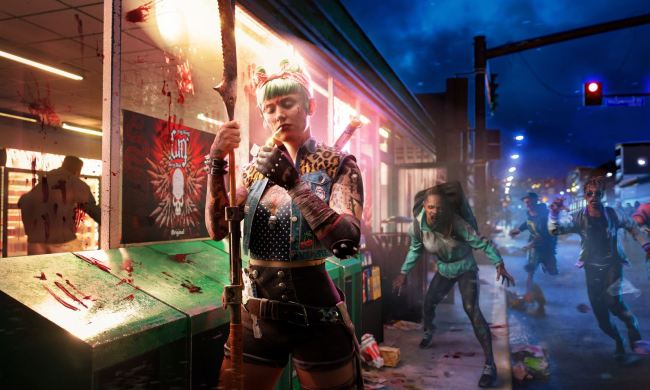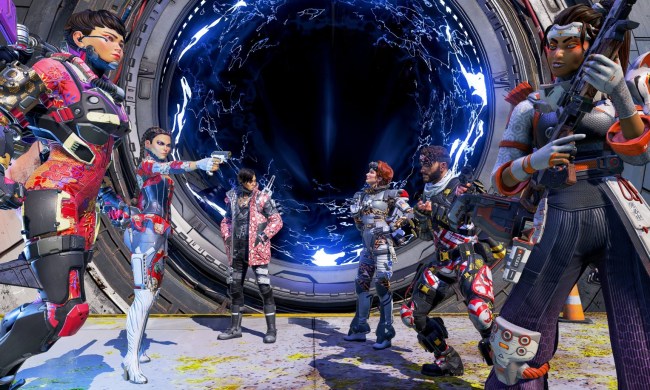Choosing your class in an RPG is about the most important decision you can make in most cases. With a game like Diablo Immortal, the class you pick can drastically change how you play the game entirely. The amount of differences in stats, skills, and playstyles can almost feel like you’re playing a completely different game, which is why it can be such a paralyzing decision to make before you even get to play the game at all.
Diablo Immortal gives you the choice of six classes right off the bat. With only a small description, you’re forced to pick one that, unless you’re willing to scrap all your progress and start again from nothing, you’ll be stuck with for dozens of hours. We’ll go through each class, giving you a good idea of their specialties, strengths, weaknesses, and what type of experience you can expect to have if you choose them so you can pick the right class for you in Diablo Immortal.
See more
- Is Diablo Immortal cross-platform?
- How to play multiplayer in Diablo Immortal
- Diablo Immortal beginner’s guide: 7 tips to get started
Barbarian

The Barbarian is probably the easiest class to understand of the lot. If you like a class that focuses on getting right in the middle of the action and hitting things really hard, this is the one for you. Their specialty is in chaining their melee hits together, as well as doing big AoE skills to wipe out big swaths of mobs at once. Naturally, the Barbarian is a tank that is best in the front lines, but at the same time you need to constantly keep track of your health. Their skills are great against groups, but not so much for bosses or single, tough foes, and generally have longer cooldowns.
You’d like the Barbarian if you want to play Diablo Immortal like an isometric hack-and-slash-style game. If you enjoy rushing in, knowing that basically any button you hit will result in hitting something in your general area, and constantly seeing damage numbers burst off, you’ll love this class. The only thing you have to do is manage your health properly to avoid an accidental death and you’re basically set.
Crusader

The Crusader is something between a magic user and melee class. They can fight both up close and at range, but they also have a lot of buffing abilities to support party members. Like the Barbarian, Crusaders have a lot of AoE skills that can crush weaker enemies in no time, but they have a few more single target options as well. This is the fastest class in the game, and many skills incorporate movement along with dealing damage, or buffing your defenses, making them a hard-to-kill class. On the other hand, your basic attacks are fairly weak, and you also have long cooldowns so, as good as they are, you’re mostly reliant on waiting for your skills to come back to be effective.
The Crusader is a good choice if you like being a kind of crowd control and support type player. Your skills are great for controlling the battlefield, staying mobile, and buffing yourself and team to avoid damage. This class requires a bit of technical skill and good party awareness to know when to deploy buffs and such, but is by no means the most complex. You won’t be the star of the party with this class, but you’ll still play an important role and have a good kit of options.
Wizard
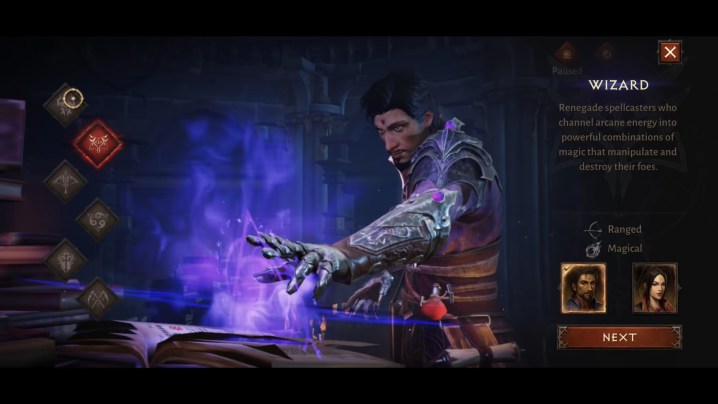
Wizards are, you guessed it, the spellcaster class in Diablo Immortal. You’ll be slinging different spells at range, comboing different types for bonuses, and unleashing a mix of both AoE and skill shot, targeted damage spells. Because of the Wizard’s high damage potential, they’re also the squishiest and easiest to kill class of the lot. Aside from raw damage output, you get some options like teleporting to keep from getting swarmed. This class is best when using their different spells in the right sequences to deal maximum damage for the specific situation. The downside is that these all require a good deal of technical skill and precision to aim, along with their naturally low HP.
Of all the classes you can start with in Diablo Immortal, the Wizard is most tuned to players already familiar with how these games work. It takes a lot to learn and fully maximize how to sling their spells not only in the best way to deal with different scenarios but also the timing and aim required to do it. If you miss, you’ll be screwed as you wait for the cooldowns with little way to defend yourself if enemies get close. If you’re up to the task, the Wizard is a very strong class.
Monk
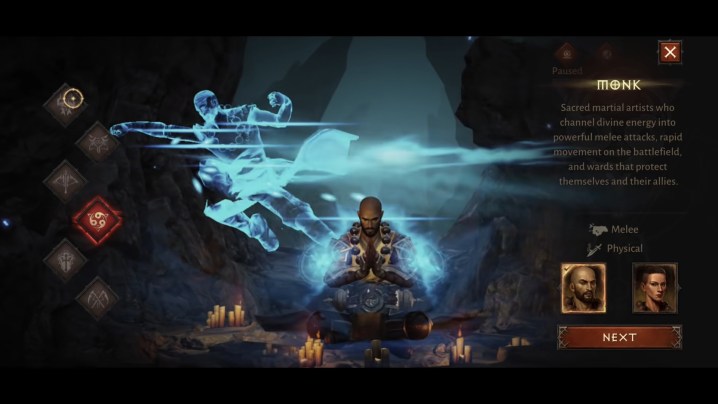
Monks are an interesting class in any game they appear in, which isn’t too many. In Diablo Immortal, they serve as a faster, more technical close-range fighter. They can dish out a lot of damage, but are not as tanky as either the Barbarian or Crusader, so they use tools instead to weave in and out of striking distance. They also have some good buffing abilities for defense, resulting in a skilled Monk looking like a technical dancer as they attack, evade, buff, and use skills to reposition themselves or enemies on the battlefield. The downside is that there isn’t a ton of versatility in your offensive options, which can end up making them feel repetitive.
The Monk is a nice pick for players who like to be able to support a team but not feel useless in a fight. Outside of their support skills, you have a nice kit of AoE and movement options to weave into your rotation. Again, the Monk is best played on a team, since they aren’t as versatile as the other classes when it comes to solo play. If you like playing a character more like they’re in an action game than just dishing out automated attacks, the Monk will have you constantly active in combat.
Necromancer
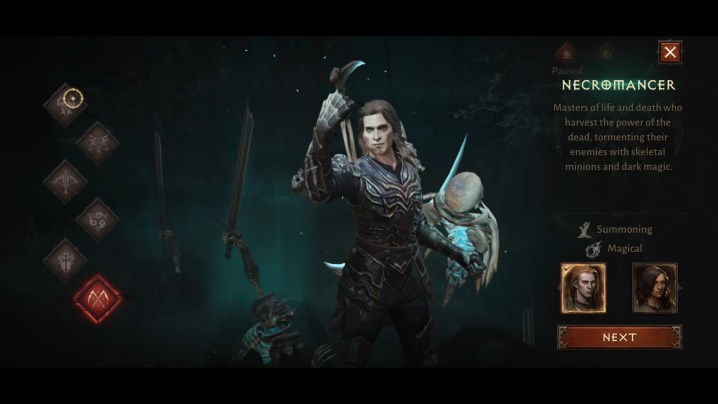
Necromancers are the one-man army class in Diablo Immortal, making them a great pick if you mostly play solo. However, the difference is that they’re all about using their minions as power, not so much themselves, making them play more like a commander than traditional character. This class is all about raising corpses to build up overwhelming odds against your enemies, summoning turrets, and using corpses as traps. The downside is that you have limited movement options compared to other characters, and are basically dependent on corpses to build up any power. What skills they do have also require you to be closer than you’d probably like.
If you can get into the flow of how the Necromancer works, this is a really strong class to pick. Once you get into the flow of raising mobs, letting them take agro, and cycling between buffing them and using corpses for some extra AoE damage, you can basically become a full team all on your own. There’s a decent learning curve to the class, and it can be slow to ramp up in power if you can’t create corpses and minions fast enough, but if you can overcome those two stumbles, the Necromancer is a fantastic class to pick.
Demon Hunter

Last up we have the edgy Demon Hunter some may recognize from Diablo 3. If you like rangers, this is the one to take a close look at. They excel at long-range encounters, dealing tons of damage in a short amount of time to keep enemies at bay, plus are quick enough to kite mobs around safely. Since they can move and use their default attack at the same time, you can constantly pick away at enemy health bars while staying safe and waiting for your more powerful abilities to come back. As strong as Demon Hunters are at taking down big, tough enemies, your AoE and general mob-killing skills are limited, and you’re naturally low in defense.
This is a fantastic class to roll as part of a crew. You can back up your tanks and more agro-focused character, and do some kiting if necessary, but Demon Hunters really shine when it comes to boss encounters. Demon Hunters have some of the highest damaging abilities against single targets, which is valuable in just about every party. They’re not too complex to play, either, though that comes at the cost of pretty much all Demon Hunter builds looking more or less the same. If you don’t mind that, there’s a ton of fun to be had blasting away with your dual crossbows.

